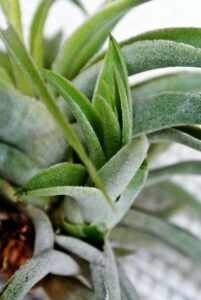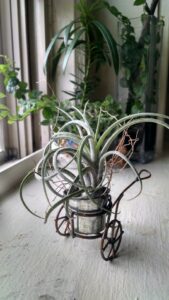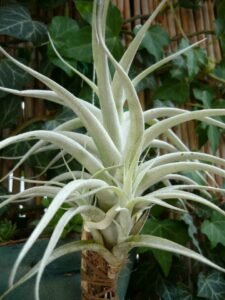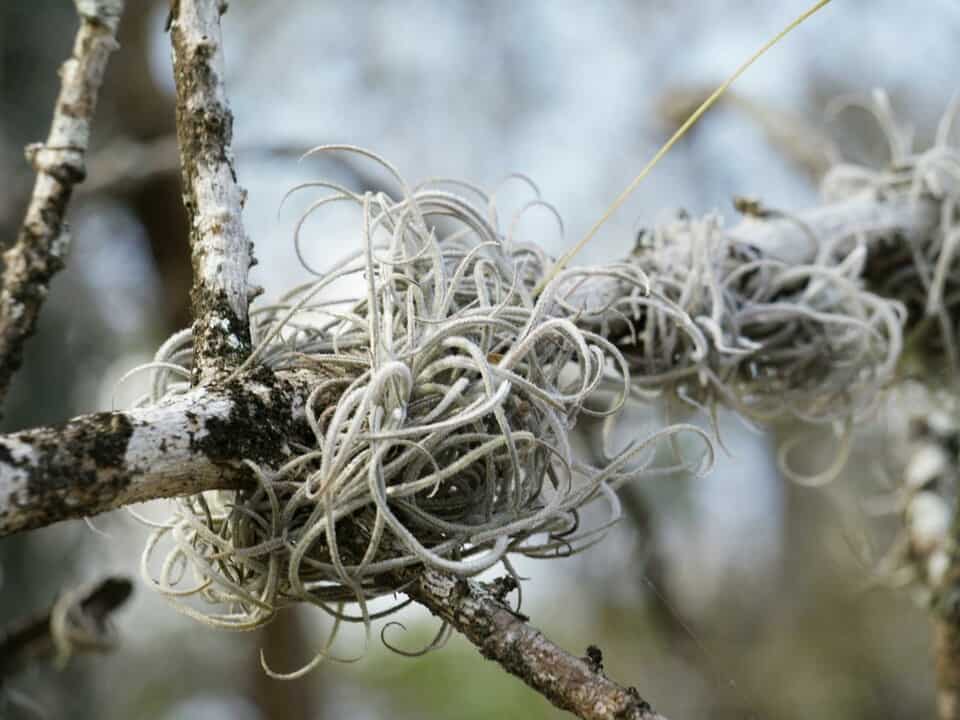Some links in the post are affiliate links and I get a commission from purchases made through some links found in the post.
Are you the type of plant parent who feels overwhelmed towards the end of fall? You can’t help but try and get everything in order as you prepare for the cold months ahead.
So, you spend time shading the outdoor plants, moving the potted plants inside, skimming through the USDA zone guides, and crossing your fingers that you will have everything ready on time.
I know how this can feel. I lost a few plants a few years back due to bad weather. The plants were great for my USDA zone, and I knew I could overwinter them outside.
Then one day, the weather got so out of hand that I had to spend the entire day indoors as there was no way to leave the house. I could not go shopping or work, let alone rush outside to tend to the dying plants.
Since then, I have always been keen on weather forecasts and always move potted plants indoors. And with the air plant, I have been particularly protective.
Why? Air plants are highly susceptible to frost damage. It takes just a few cold winter drafts to kill the plant – that’s how easily you can lose a good plant to bad weather.
That’s not all that can kill your air plant in the winter. Other than frost, Overwatering, underwatering, overfeeding, poor lighting, and low humidity can wreak havoc in your household.
I will take you through how to overwinter your air plant with success each year.
What Temperature Is Too Cold for An Air Plant?
 One of the main reasons some plants don’t make it to the end of winter is that they suffer frost damage.
One of the main reasons some plants don’t make it to the end of winter is that they suffer frost damage.
I keep using the term frost rather than cold because, for most people, the former is the real concern.
However, some areas may not have harsh winters, but the drafts may be cold enough to kill the air plant. So, how cold is too cold for an air plant?
Air plants prefer temperatures between 55- and 90-degrees Fahrenheit. As you start moving to lower temperatures, the plant suffers the effects of cold weather, hampering its ability to sustain its cellular activities.
But in most cases, the plant will only show signs of distress once you go lower than 45 degrees. Anything lower than 40 degrees is a huge risk, even if it is only for a day.
As I said, it takes only one bad draft for your plant to bear the brunt of cold weather. And most air plants will die after such exposure.
How Do You Take Care of An Air Plant In The Winter?
Taking care of your air plant changes a bit in the winter. Below are some of the key areas that you must focus on to keep your plant alive:
Temperature
Air plants die upon frost exposure. To protect your plant, ensure that the temperature is at least 50 degrees Fahrenheit.
It would be better off if you could locate it in a spot where the temperatures lie between 60 and 90 degrees.
In most cases, you don’t need to do much to hit such ranges because the indoor temperatures will be close to or within this range.
The best way to gauge how the air plant will react is to assess how comfortable you are in the space. If you feel cold, the plant will also likely feel chilly. But if you feel okay, so will the plant.
If your home feels chilly despite having heaters in place, you can move the air plant to the bathroom or kitchen. Such placement also has the added advantage of more humidity, but we will get to that part later.
Below are spots you must avoid:
- Do not place the air plant near a window, door, or other openings with direct access to the outdoors. As you open and close these openings, cold drafts will reach your plant and can damage it.
- The plant should not be near any cooling vents either, as these can push too much cold air towards the plant, adversely affecting it.
- While you may want to keep your plant warm, do not place it near direct heat sources. These include heating vents, heaters, cookers, or any other surfaces which emit a lot of heat. Air plants can suffer foliage damage, thereby affecting their ability to make food as the plant focuses on healing the damaged plant parts.
Look for spots with consistent temperatures in the ideal range between 60 and 90 degrees, and your plant will be fine.
Humidity
In the winter, humidity levels tend to drop significantly. The levels are further worsened by the use of fireplaces and heaters that dry the air.
Air plants may have a hard time surviving in these conditions. And they can show their distress in the form of drying and curling leaves, despite a regular watering schedule. To deal with these changes, you should:
- Increase the watering schedule by misting the plant more frequently,
- Leave the plant in a spot far from windows, vents, or any openings that push air into the home,
- Invest in a humidifier or place a bowl of water near the plant, or
- Move the plant to the kitchen or bathroom to allow it more access to humidity.
Bathing the air plant is not advisable as it may not dry well in winter conditions.
For more information on the humidity, we have an article on what is the ideal humidity for a air plant.
Watering
There’s a general rule of thumb that almost all gardeners live by – you must reduce watering in the winter once your plant starts going dormant.
Do you live by this rule? With the air plant, you will have no choice but to adjust your watering schedule. Why?
In the summer and other hot months, you should water your air plant once or twice a week using the dunking or soaking method.
And this works because the environment is hot enough to allow the plant processes to take place, i.e., evaporation and transpiration.
Even so, there is always the risk of overwatering, which can lead to root rot, even with these optimal conditions.
So, in the winter, you must cut back on watering the plant. However, the frequency will depend on how humid the environment is – the more humid it is, the less water the plant will need.
Ideally, the plant can make do with one misting every two weeks. Follow the same procedure as you would in the summer by shaking the excess water off and leaving the plant to dry before hanging it or leaving it in a container.
Not watering the plant often does not mean you should neglect it. The plant relies on water for nutrients, and without it, its survival is at risk. Below are the signs that you may need to alter your watering schedule:
1) Overwatering

If you mist your plant more than it needs, it will show signs of yellowing, brown or black spots in its center, sogginess, and even the falling of leaves.
Some of these may relate to root rot which can kill the plant. So, you will need to use a sharp and clean knife to cut off the affected parts before treating the plant with a fungicide.
Then leave it under direct sun for two days to allow it to dry before you move it to its usual location and alter its watering schedule.
2) Underwatering
Sometimes, your plant may go so long without water that it ends up dehydrated. And you can tell it has reached this point when its leaves start yellowing, curling, drying, and developing a pale color.
Adjust the watering schedule accordingly, keeping humidity levels in mind.
Lighting
Most air plants prefer bright indirect light in all seasons. However, they can tolerate higher amounts of light if the humidity in the home is also high.
In the winter, accessing adequate lighting is often an issue. But your plant still needs enough light to make food and keep growing. So, how do you handle this?
1) Place your plant in a spot where it can access bright and indirect light. Ideally, this should be near a south or west-facing window.
Ideally, the plant should be a few feet away from the window such that the rays do not hit the plant directly.
Please do not place your plant against the window as the sun’s rays may damage its foliage. However, there is a caveat to this placement, as I detail in the point below.
2) If your plant shows signs of not getting adequate light, move it against the west or south-facing window.
Why? In the winter, the sun takes on a lower angle, and its rays may not be as harsh as in other seasons. As a result, the plant may withstand direct sunlight without showing signs of foliage damage.
3) If you cannot access enough natural light for your plant, you can supplement the available light with full-spectrum artificial lights.
Options include halogen bulbs, fluorescent bulbs, LED lights, and incandescent bulbs. Please note that some of these lights emit a lot of heat and should not be near the plant.
A good example is an incandescent bulb. While it emits a full spectrum, its heat emission can be as damaging to the plant leaves as the sun.
So, you must leave the light a few feet from the plant. I would advise that you get LED lights as they have the least heat emission due to their high energy efficiency.
You may also like: 8 air plant problems & how to fix them
How Much Light does an Air Plant Need in the Winter?
Your plant should access at least five hours of light each day – this can be natural or artificial lighting. In the latter case, you must equate the exposure time to that of natural lighting.
For example, if your plant gets 2 hours of natural bright and indirect light, you can leave the artificial light on for 3 hours to allow it enough access.
Can you Tell if your Air Plant Needs More Light?
Air plants communicate the need for more light by exhibiting stunted growth, pale leaf colors, falling leaves, and withering.
If you notice such signs, you either need to move the plant closer to a window or invest in artificial lighting.
Leaving it in such a state does not help matters. The plant keeps making less food to the point that it can no longer sustain its growth, thus dying.
Are you Giving your Air Plant Too Much Light?
While direct sun exposure may not be as damaging in the winter as in other seasons, it can still result in visible adverse changes.
Your plant may start showing signs of yellowing, spotting, crisping, curling, and even loss of color. Such signs indicate that the plant needs less light.
Keep in mind that artificial lighting can also cause such problems. So, you may need to reduce the exposure time or increase the distance between the light and the plant.
PS: You may notice that I have not mentioned feeding in this guide. That’s because your air plant does not need any feeding during winter.
Save the feed for the spring when the plant starts actively growing. Else, winter feeding can lead to fertilizer burn, killing the plant.
You may also like: How Big Can an Air Plant Get
Do Air Plants Go Dormant in The Winter?
Air plants are like most other houseplants. And when winter comes along, their growth and cellular activities slow down, almost coming to a halt.
As such, your plant will not need as much water, nor will it need any fertilizer. However, the plant will not be completely dormant, and some growth will still occur.
You will thus need to ensure it gets enough water to sustain its usual activities. Otherwise, the plant could enter actual dormancy and start showing signs of distress such as browning, yellowing, and even crisping its leaves.
During winter, you still need to remember that your air plant needs care. It might not be as much as what you would give it in other seasons, but it is still crucial.
Please use the earlier outlined guidelines to help you know where to cut back and where to be more attentive.
Can Air Plants Freeze?
 Air plants are very particular when it comes to temperatures. While they will withstand extremely hot temperatures to some extent, they are not the same when it comes to cold conditions.
Air plants are very particular when it comes to temperatures. While they will withstand extremely hot temperatures to some extent, they are not the same when it comes to cold conditions.
Once you hit the 55-degree Fahrenheit mark, the plants start to suffer from cold shock. Some are hardier and will withstand anything up to 45 degrees before showing signs of distress.
And if you do not change their conditions, they die as the natural plant processes cannot continue in such a space.
Unfortunately, you cannot revive a plant that has suffered frost damage. All you can do is discard it and plant another one in the spring.
To be on the safe side, it’s best to avoid such an outcome by winterizing your air plant right from the start, as stated above.
Final Thoughts
Once you have gone through the above requirements, you’ll realize that placing your air plants indoors gives them the best chance of survival.
Here, you can regulate their temperature, humidity, watering, and even lighting. So, that would be the first thing I would advise you to do.
Even before fall ends and the first signs of frost start to show, move your plant indoors. That will allow it enough time to acclimate as you prepare to winterize it.
Happy Gardening!

